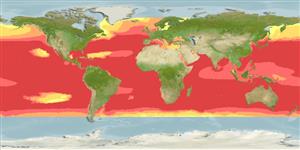Environment: milieu / climate zone / depth range / distribution range
Ökologie
seewasser; ozeanodrom (Ref. 51243); tiefenbereich 0 - 2878 m (Ref. 116993), usually 0 - 550 m (Ref. 54934). Temperate; 5°C - 27°C (Ref. 43); 69°N - 50°S, 180°W - 180°E (Ref. 54934)
Atlantic, Indian and Pacific: tropical and temperate and sometimes cold waters, including the Mediterranean Sea, the Sea of Marmara, the Black Sea, and the Sea of Azov. Highly migratory species. Mt DNA restriction analysis reveal that genetic differentiation occurs between populations inhabiting the Mediterranean Sea and the tropical Atlantic ocean, indicating little genetic exchange occurring between the two (Ref. 12784).
Length at first maturity / Size / Gewicht / Alter
Maturity: Lm 212.0, range 156 - 250 cm
Max length : 455 cm FL Männchen/unbestimmt; (Ref. 40637); common length : 300 cm TL Männchen/unbestimmt; (Ref. 9354); max. veröff. Gewicht: 650.0 kg (Ref. 4689)
Rückenflossenstacheln (insgesamt) : 0; Rückenflossenweichstrahlen (insgesamt) : 38 - 56; Afterflossenstacheln: 0; Afterflossenweichstrahlen: 16 - 18. Blackish-brown fading to light-brown below; 1st dorsal fin with blackish-brown membrane, other fins brown or blackish-brown (Ref. 43). A long, flat, sword-like bill and no pelvic fins (Ref. 26938).
Oceanic but sometimes found in coastal waters (Ref. 9354). Generally above the thermocline (Ref. 9354), preferring temperatures of 18°C to 22°C (Ref. 9987). Larvae are frequently encountered at temperatures above 24 °C (Ref. 9702). Migrate toward temperate or cold waters in the summer and back to warm waters in the fall. Adults are opportunistic feeders, known to forage for their food from the surface to the bottom over a wide depth range (Ref. 9702). Feed mainly on fishes (Atlantic mackerel, barracudinas, silver hake, redfish, herring and lanternfishes (Ref. 5951); also on crustaceans and squids (Ref. 9354). They use their sword to kill their prey (Ref. 9354). Large individuals may accumulate large percentages of mercury in its flesh (Ref. 9354). Are batch spawners (Ref. 51846). Spawning takes place in Atlantic during spring in southern Sargasso Sea. Migrate to cooler waters to feed (Ref. 4689). Females grow fastest. Determination of age is difficult since the otoliths are very small and scales are missing in adults. Year rings have been successfully counted on cross sections of the fin rays (Ref. 35388). Pelagic eggs measure 1.6-1.8mm and the newly hatched larvae is 4 mm long. Sword is well developed at a length of 10mm and young live pelagically in the upper water layers where they quickly develop into very voracious predators (Ref. 35388). Mt DNA restriction analysis reveal that genetic differentiation occurs between populations inhabiting the Mediterranean Sea and the tropical Atlantic ocean, indicating little genetic exchange occurring between the two (Ref. 12784). Good food fish, marketed fresh or frozen, and can be made into sashimi, teriyaki or fillets (Ref. 9354).
In the Atlantic Ocean, spawning occurs in the upper water layer at depths between 0 and 75 m, at temperatures around 23°C, and salinity of 33.8 to 37.4 ppt.
The distribution of larval broadbill swordfish in the Pacific Ocean indicates that spawning occurs mainly in waters with a temperature of 24°C or more. Spawning appears to occur in all seasons in equatorial waters, but is restricted to spring and summer at higher latitudes (Ref. 30448).
Fertilisation in broadbill swordfish is external and pairing of solitary males and females is thought to occur when spawning (Ref. 9742). Broadbill swordfish are reported to spawn in the upper layers of the water column, from the surface to a depth of 75 m (Ref. 43).
Estimates of egg numbers vary considerably, from 1 million to 16 million in 168,000 g female (Ref. 9742) and 29 million in a 272,000 g female (Ref. 30372).
Nakamura, I., 1985. FAO species catalogue. Vol. 5. Billfishes of the world. An annotated and illustrated catalogue of marlins, sailfishes, spearfishes and swordfishes known to date. FAO Fish. Synop. 125(5):65p. Rome: FAO. (Ref. 43)
IUCN Rote Liste Status (Ref. 130435: Version 2024-2)
Nutzung durch Menschen
Fischereien: kommerziell; Sportfisch: ja
Tools
Zusatzinformationen
Download XML
Internet Quellen
Estimates based on models
Preferred temperature (Ref.
123201): 10.9 - 27.6, mean 22.7 °C (based on 5276 cells).
Phylogenetic diversity index (Ref.
82804): PD
50 = 1.5000 [Uniqueness, from 0.5 = low to 2.0 = high].
Bayesian length-weight: a=0.00380 (0.00160 - 0.00904), b=3.15 (2.93 - 3.37), in cm total length, based on LWR estimates for this (Sub)family-body shape (Ref.
93245).
Trophic level (Ref.
69278): 4.5 ±0.2 se; based on diet studies.
Generation time: 8.9 (6.1 - 13.7) years. Estimated as median ln(3)/K based on 11
growth studies.
Widerstandsfähigkeit (Ref.
120179): mittel, Verdopplung der Population dauert 1,4 - 4,4 Jahre. (rm=0.076; K=0.23; tm=5-6; tmax=9).
Prior r = 0.46, 95% CL = 0.30 - 0.69, Based on 17 full stock assessments.
Fishing Vulnerability (Ref.
59153): High to very high vulnerability (72 of 100).
Climate Vulnerability (Ref.
125649): Moderate vulnerability (43 of 100).
Nutrients (Ref.
124155): Calcium = 9 [4, 16] mg/100g; Iron = 0.278 [0.142, 0.491] mg/100g; Protein = 19.3 [17.0, 22.1] %; Omega3 = 0.333 [0.155, 0.694] g/100g; Selenium = 44.1 [17.4, 121.6] μg/100g; VitaminA = 5.71 [1.63, 20.67] μg/100g; Zinc = 0.443 [0.157, 0.783] mg/100g (wet weight); based on
nutrient studies.
